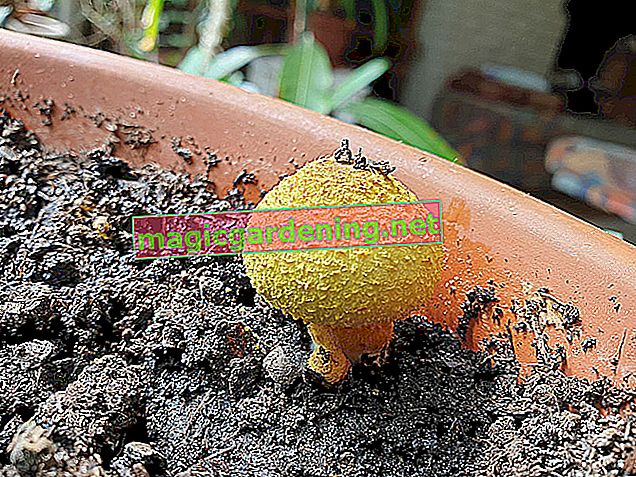
Plant marigolds properly
You can plant the marigold grown yourself or bought in a garden center in a sunny spot from mid-May. To do this, rake through the fresh, nutrient-rich soil thoroughly in order to dig small pits at a distance of 25-30 cm. Shovel the earth into a bucket or wheelbarrow to mix in compost and horn shavings (€ 6.39 on Amazon *). Now pot the marigolds and place a plant in each hole. Use the enriched substrate to fill the planting hole to just below the first pair of leaves. After dousing water at room temperature, mulch with leaves or clippings.
Continue reading
also read
- Caring for the Tagetes - it's easy with our tips
- Hibernating marigolds, is that possible?
- The ideal location for the marigolds
Care tips
The marigold owes its name not least to the fact that it can be cared for without many years of experience. We have put together all the important aspects for you here:
- Weed weeds consistently from day one
- Always water the marigolds when the substrate is dry
- No regular fertilization is required in the bed; Every now and then a portion of compost is an advantage
- Fertilize the marigold in pots and balcony boxes every 3-4 weeks from June to October
- Cut off withered flower heads promptly to make room for a second bloom
If you leave some flowers in the bed from August / September, the annual plant will do the self-sowing without any further action. It is important to note that direct skin contact with the plant sap is phototoxic and can trigger an allergic reaction. Therefore, always wear gloves for all work around the velvet flower.
Continue reading
Which location is suitable?
In the sunny to partially shaded location, the marigold thrives in any normal garden soil. In the best case, the velvet flower finds a well-drained, humus-rich and not too heavy soil. For locations exposed to rain and wind, there is a choice of robust varieties that bravely stand up to the rigors of the weather.
Continue reading
The correct planting distance
The selected variety determines the respective planting distance. The dwarf varieties Tagetes nana reach a maximum height of 20 cm, so a distance of 15-20 cm is well chosen. The vast majority of Tagetes thrive 30-40 cm high, which suggests an ideal planting distance of 25-30 cm. Only the mighty Tagetes erecta, which stretch up to 120 cm high, are settled at a distance of 80-100 cm.
What soil does the plant need?
The marigold is not picky about the nature of the soil. As long as it can get enough sunlight, it will thrive in any normal garden soil. Tagetes achieve their optimum in a fresh, moist, humus-rich and nutrient-rich soil. For cultivation in pots and balcony boxes, we recommend commercially available compost-based potting soil with a low proportion of peat. A handful of sand or expanded clay (€ 17.50 at Amazon *) improves permeability and prevents waterlogging.
What is the best time to plant?
The South American immigrant cannot cope with cold or even frosty temperatures. You should therefore plant your preferred marigold in the bed from mid-May at the earliest. For direct sowing, on the other hand, the time window opens as early as the end of April, provided that late frosts are no longer announced at this time.
Continue reading
When is the flowering time?
With the first warm days from mid-May, the marigold begins a flowering period that lasts until the first frost. If you clean dead flowers regularly, you will support a seamless, picturesque flower pile. At the same time, you save the hardworking marigolds the exhausting growth of seed heads.
Continue reading
Cut the marigold properly
Cut off withered flower heads continuously, favor a lush, long-lasting flower pile. At the same time, the debilitating seed growth is stopped in the middle of the season. Do not leave the flowers of a marigold in the bed until August / September. You can choose to harvest the seeds for sowing behind glass or let the marigolds do the propagation on their own. After the first frost, the flowers inevitably freeze off, so that the plant remains can be raked under in spring.
Pour the marigolds
The marigold feels comfortable in a slightly damp soil that dries up in the meantime. Water the velvet flower whenever the thumb test indicates that the substrate has dried on. On hot summer days, this may be necessary every day, especially in the tub or flower box (€ 13.18 at Amazon *). Do not water marigolds in direct sunlight, but in the morning or evening hours. In sunlight, every single drop of water on flowers and leaves turns into a magnifying glass, which leads to considerable damage to the plant tissue.
Fertilize the marigolds properly
The marigold does not require a regular supply of nutrients in the bed. If you are already out in the garden with the wheelbarrow full of ripe compost, the plant will gratefully accept a portion. Work in the organic material on the surface and pour more. If marigolds thrive in pots and balcony boxes, fertilize every 3-4 weeks from June to October with a liquid fertilizer for flowering plants.
Pests
Unfortunately, the marigold exerts a magical attraction on snails. Clever hobby gardeners use the plant as a natural protective shield for their vegetable patches by planting marigolds as a border. The advancing snail company is distracted by lettuce, strawberries, tomatoes and other crops. If you want to keep the velvet flower as an ornament, we recommend taking protective measures against the voracious pests. A snail fence keeps snails off, as do walking barriers made of grit or thick wood chips. Sprinkle coffee grounds regularly, as the caffeine is toxic to the beasts. If you decide to use slug pellets when there is high infestation pressure, we recommend spreading it in crevice traps,so that the harmless snails do not fall victim to the poison.
Overwinter
Native to the warm tropical regions of South America, the marigold is not frost-resistant. At temperatures below -5 degrees Celsius, the flower freezes off. Although a few species and varieties thrive for several years, it is not worth the effort to overwinter. If you dare to experiment, bring the marigold in a pot or flower box to a light, frost-free winter area in good time. At temperatures of 15 to 18 degrees Celsius you only water a little and do not give any fertilizer.
Continue reading
Propagate marigolds
So that you don't miss the radiance of marigolds in the next year, we recommend uncomplicated propagation by sowing. To do this, collect completely withered flowers on a dry day in autumn. Spread the harvest out on kitchen paper for a few days in an airy, dry place. Then fill the dried flower heads with the seeds they contain in a can with a lid or a bag and shake vigorously. Now sift the seeds through a kitchen sieve onto a plate. Keep the seeds in the airtight, dark screw-top jar in the cool cellar until next spring. This is how the sowing works:
- In March, fill a seed tray with seed soil or peat sand and moisten it
- Scatter the seeds, press lightly, do not sieve over or at most 5 mm
- Keep it slightly damp at 15-18 degrees Celsius in the airy, light window seat
- Prick out the seedlings in individual pots about 14 days after emergence
- Continue to cultivate in a warm, partially shaded location until mid-May
Alternatively, sow the seeds directly into the bed as soon as there is no more frost to be expected from the end of April. Prepare a fine crumbly seedbed with shallow grooves spaced 20-30 cm apart. A close-knit network repels hungry gardeners and voracious pests. Keep the soil slightly moist in order to separate the strongest seedlings 2 weeks after emergence at a distance of 25-30 cm.
Continue reading
Tagetes in a pot
In the pot and flower box, you save the marigold stressful pricking out and repotting if you sow directly on the potting soil. A water-bearing layer of potsherds or grit on the floor effectively prevents waterlogging. From the end of April sprinkle the fine seeds on the substrate, press them lightly and moisten with a fine shower. In a bright, not full sun location, water regularly without completely watering the soil. Depending on the variety, separate the seedlings at a distance of 10-15 cm. If the Tagetes with 4-6 leaves are soaked once, they branch out particularly bushy. Always water the velvet flowers when the substrate has dried. From June until the end of the flowering period, give a liquid fertilizer every 3-4 weeks. Cut off the withered flower heads every few days,draw out the next blossoms.
Is marigold poisonous?
The marigold contains thiophene, an organic compound that is phototoxic. Skin contact with the sap under light can trigger dermatitis, a very unpleasant skin disease. Therefore, wear gloves for all planting and maintenance work. In addition, marigolds do not pose a health risk, so there is nothing against cultivation in the family garden.
Continue reading
Nice varieties
- Gold dwarf: popular marigold with unmistakable, yellow flower heads; 15-30 cm
- Cresto Orange: The variety convinces with double flowers in bright orange and an extra early flowering time from May; 15-30 cm
- Mr. Magjestic: noble variety that sets the scene with yellow-brown striped flowers; rainproof and durable; 25-30 cm
- Fiesta: beautiful mahogany colored flower balls for borders, flower beds and flower boxes
- Gold piece: A majestic Tagetes erecta, whose lemon-yellow flowers stretch up to 120 cm high towards the sky
- Sperling's Eskimo: The steadfast, vigorous marigold captivates with its cream-colored flowers; 50 cm
- Queen Bee: Compact Tagetes nana with double flowers in yellow and reddish brown; 15-25 cm
- Honeycomb: An indestructible velvet flower whose honey-yellow flowers form dense cushions; 25 cm








